Lawrence Wang
Can Stability be Detrimental? Better Generalization through Gradient Descent Instabilities
Dec 23, 2024



Abstract:Traditional analyses of gradient descent optimization show that, when the largest eigenvalue of the loss Hessian - often referred to as the sharpness - is below a critical learning-rate threshold, then training is 'stable' and training loss decreases monotonically. Recent studies, however, have suggested that the majority of modern deep neural networks achieve good performance despite operating outside this stable regime. In this work, we demonstrate that such instabilities, induced by large learning rates, move model parameters toward flatter regions of the loss landscape. Our crucial insight lies in noting that, during these instabilities, the orientation of the Hessian eigenvectors rotate. This, we conjecture, allows the model to explore regions of the loss landscape that display more desirable geometrical properties for generalization, such as flatness. These rotations are a consequence of network depth, and we prove that for any network with depth > 1, unstable growth in parameters cause rotations in the principal components of the Hessian, which promote exploration of the parameter space away from unstable directions. Our empirical studies reveal an implicit regularization effect in gradient descent with large learning rates operating beyond the stability threshold. We find these lead to excellent generalization performance on modern benchmark datasets.
The instabilities of large learning rate training: a loss landscape view
Jul 22, 2023Abstract:Modern neural networks are undeniably successful. Numerous works study how the curvature of loss landscapes can affect the quality of solutions. In this work we study the loss landscape by considering the Hessian matrix during network training with large learning rates - an attractive regime that is (in)famously unstable. We characterise the instabilities of gradient descent, and we observe the striking phenomena of \textit{landscape flattening} and \textit{landscape shift}, both of which are intimately connected to the instabilities of training.
SANE: The phases of gradient descent through Sharpness Adjusted Number of Effective parameters
May 29, 2023



Abstract:Modern neural networks are undeniably successful. Numerous studies have investigated how the curvature of loss landscapes can affect the quality of solutions. In this work we consider the Hessian matrix during network training. We reiterate the connection between the number of "well-determined" or "effective" parameters and the generalisation performance of neural nets, and we demonstrate its use as a tool for model comparison. By considering the local curvature, we propose Sharpness Adjusted Number of Effective parameters (SANE), a measure of effective dimensionality for the quality of solutions. We show that SANE is robust to large learning rates, which represent learning regimes that are attractive but (in)famously unstable. We provide evidence and characterise the Hessian shifts across "loss basins" at large learning rates. Finally, extending our analysis to deeper neural networks, we provide an approximation to the full-network Hessian, exploiting the natural ordering of neural weights, and use this approximation to provide extensive empirical evidence for our claims.
HumBugDB: A Large-scale Acoustic Mosquito Dataset
Oct 14, 2021

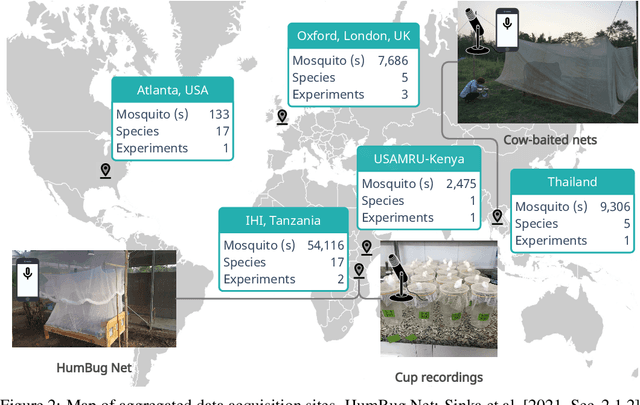
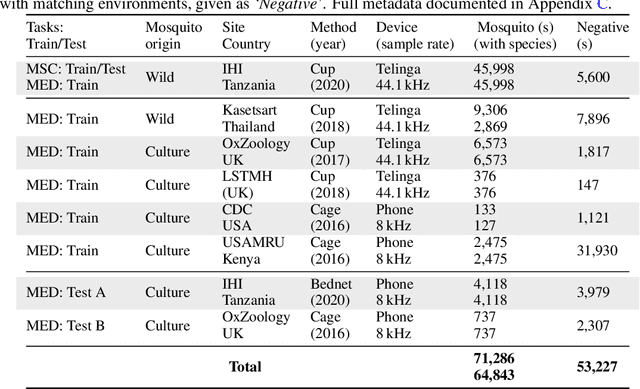
Abstract:This paper presents the first large-scale multi-species dataset of acoustic recordings of mosquitoes tracked continuously in free flight. We present 20 hours of audio recordings that we have expertly labelled and tagged precisely in time. Significantly, 18 hours of recordings contain annotations from 36 different species. Mosquitoes are well-known carriers of diseases such as malaria, dengue and yellow fever. Collecting this dataset is motivated by the need to assist applications which utilise mosquito acoustics to conduct surveys to help predict outbreaks and inform intervention policy. The task of detecting mosquitoes from the sound of their wingbeats is challenging due to the difficulty in collecting recordings from realistic scenarios. To address this, as part of the HumBug project, we conducted global experiments to record mosquitoes ranging from those bred in culture cages to mosquitoes captured in the wild. Consequently, the audio recordings vary in signal-to-noise ratio and contain a broad range of indoor and outdoor background environments from Tanzania, Thailand, Kenya, the USA and the UK. In this paper we describe in detail how we collected, labelled and curated the data. The data is provided from a PostgreSQL database, which contains important metadata such as the capture method, age, feeding status and gender of the mosquitoes. Additionally, we provide code to extract features and train Bayesian convolutional neural networks for two key tasks: the identification of mosquitoes from their corresponding background environments, and the classification of detected mosquitoes into species. Our extensive dataset is both challenging to machine learning researchers focusing on acoustic identification, and critical to entomologists, geo-spatial modellers and other domain experts to understand mosquito behaviour, model their distribution, and manage the threat they pose to humans.
HumBug Zooniverse: a crowd-sourced acoustic mosquito dataset
Feb 14, 2020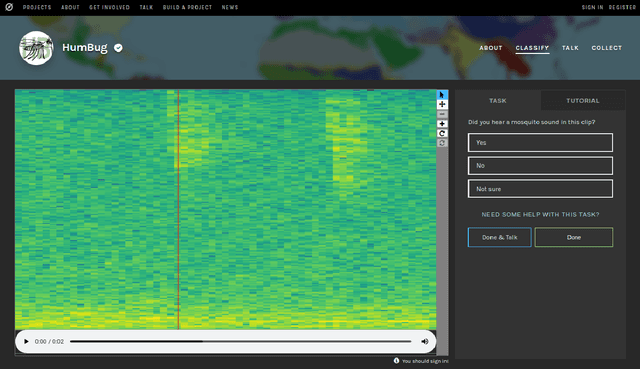
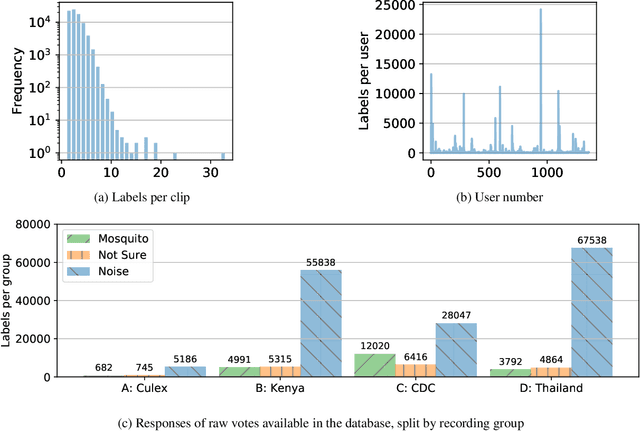
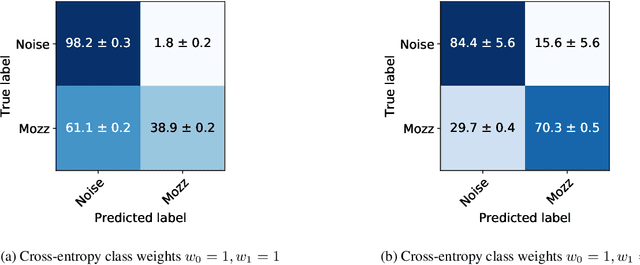
Abstract:Mosquitoes are the only known vector of malaria, which leads to hundreds of thousands of deaths each year. Understanding the number and location of potential mosquito vectors is of paramount importance to aid the reduction of malaria transmission cases. In recent years, deep learning has become widely used for bioacoustic classification tasks. In order to enable further research applications in this field, we release a new dataset of mosquito audio recordings. With over a thousand contributors, we obtained 195,434 labels of two second duration, of which approximately 10 percent signify mosquito events. We present an example use of the dataset, in which we train a convolutional neural network on log-Mel features, showcasing the information content of the labels. We hope this will become a vital resource for those researching all aspects of malaria, and add to the existing audio datasets for bioacoustic detection and signal processing.
 Add to Chrome
Add to Chrome Add to Firefox
Add to Firefox Add to Edge
Add to Edge